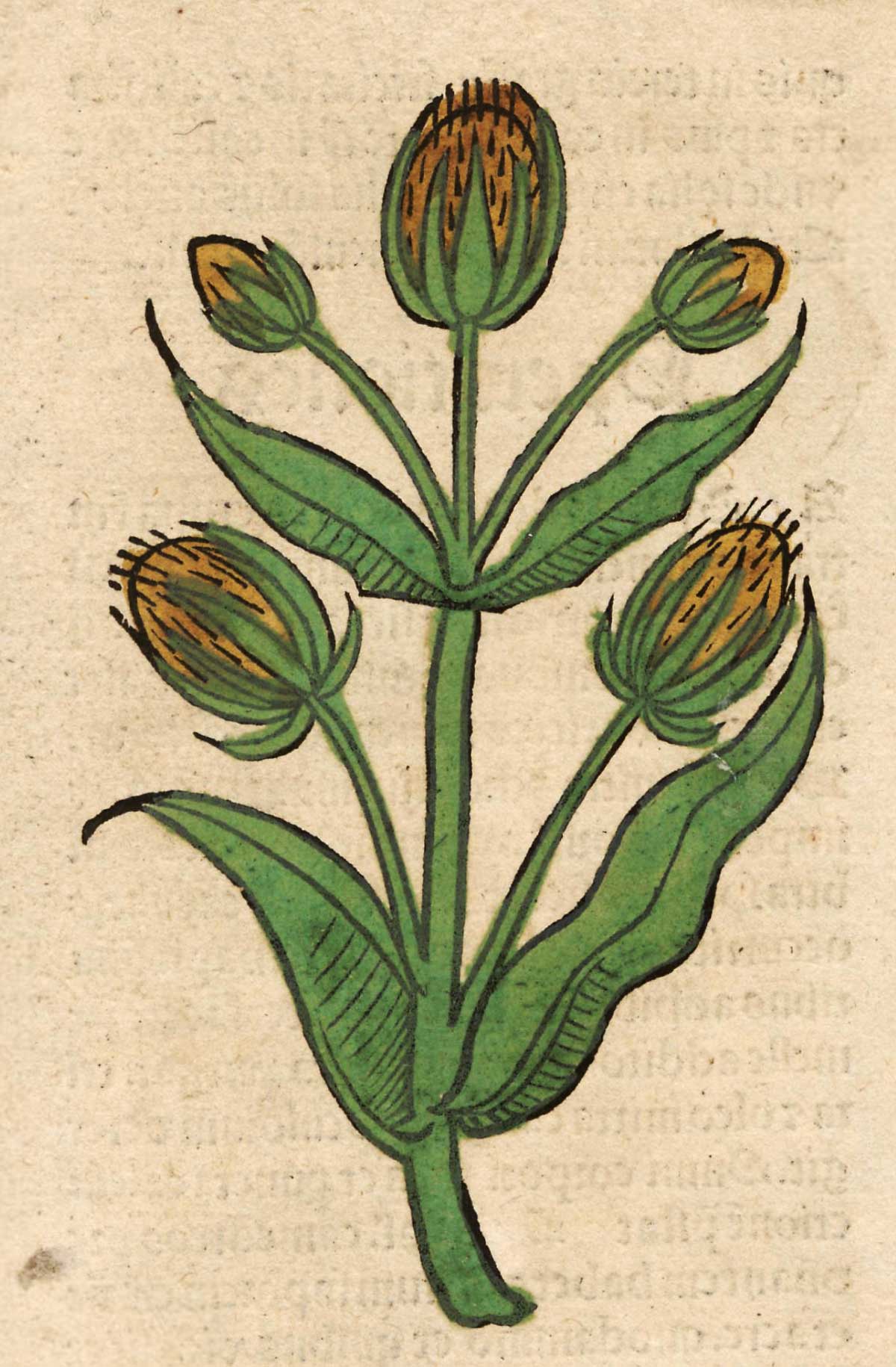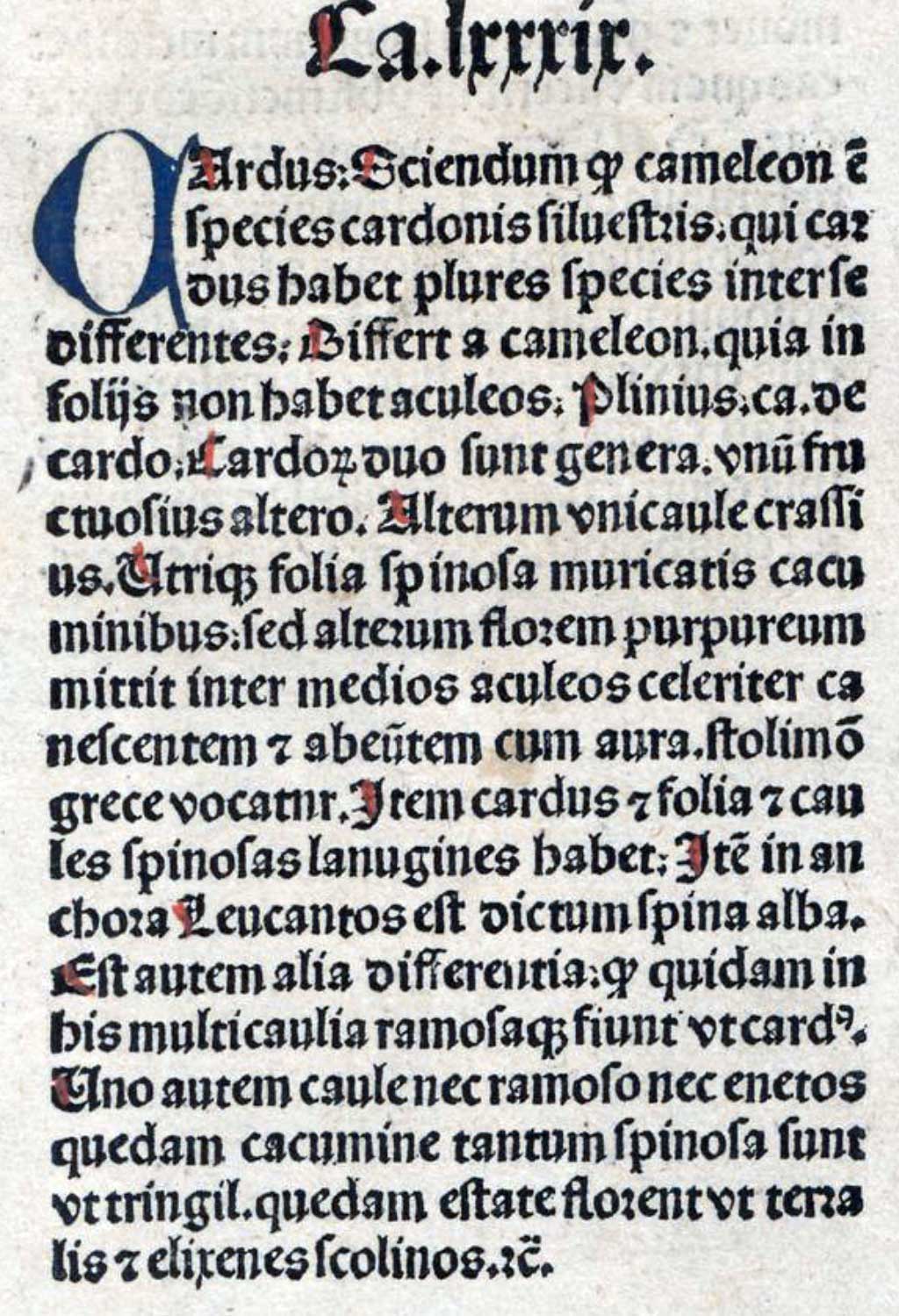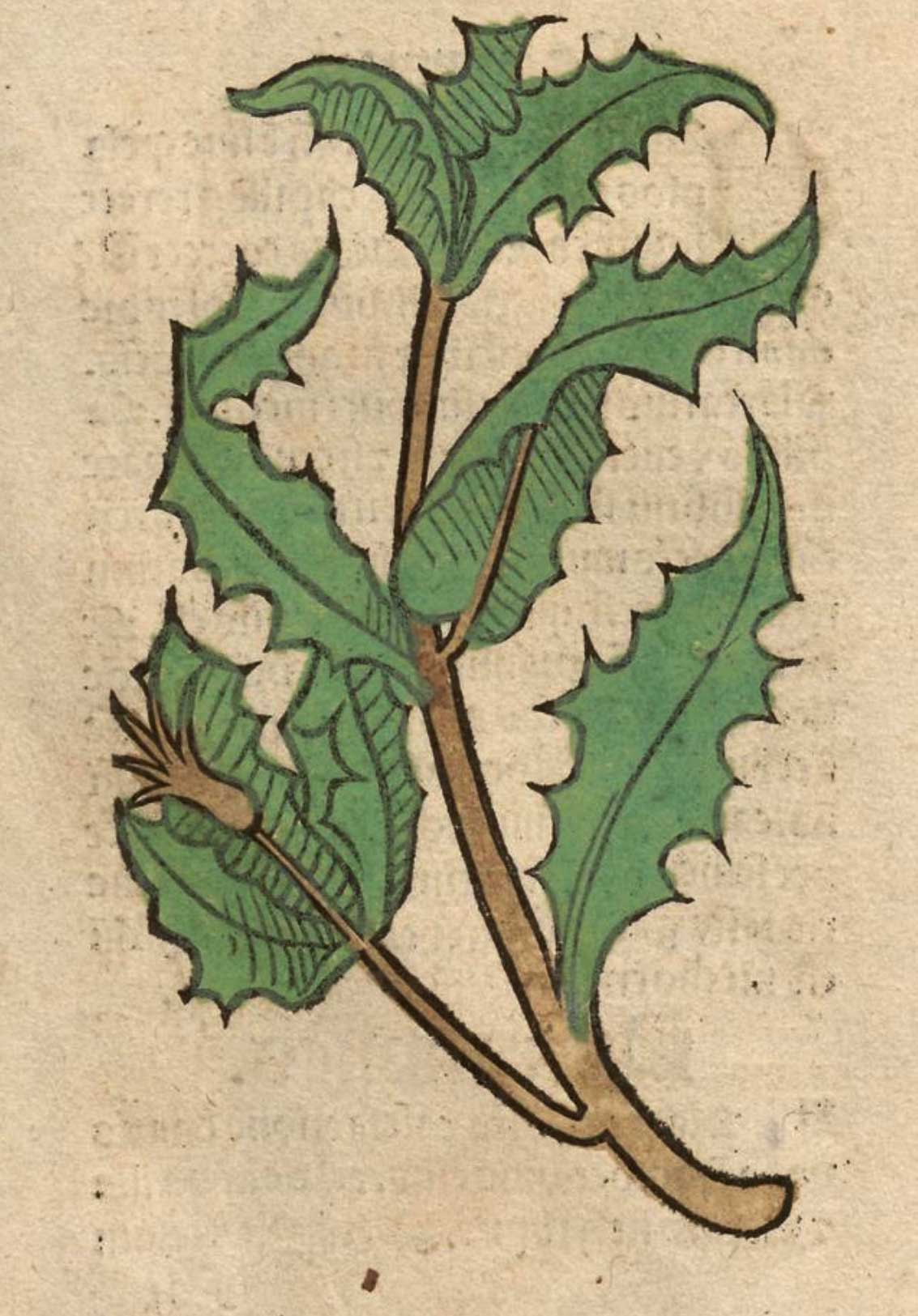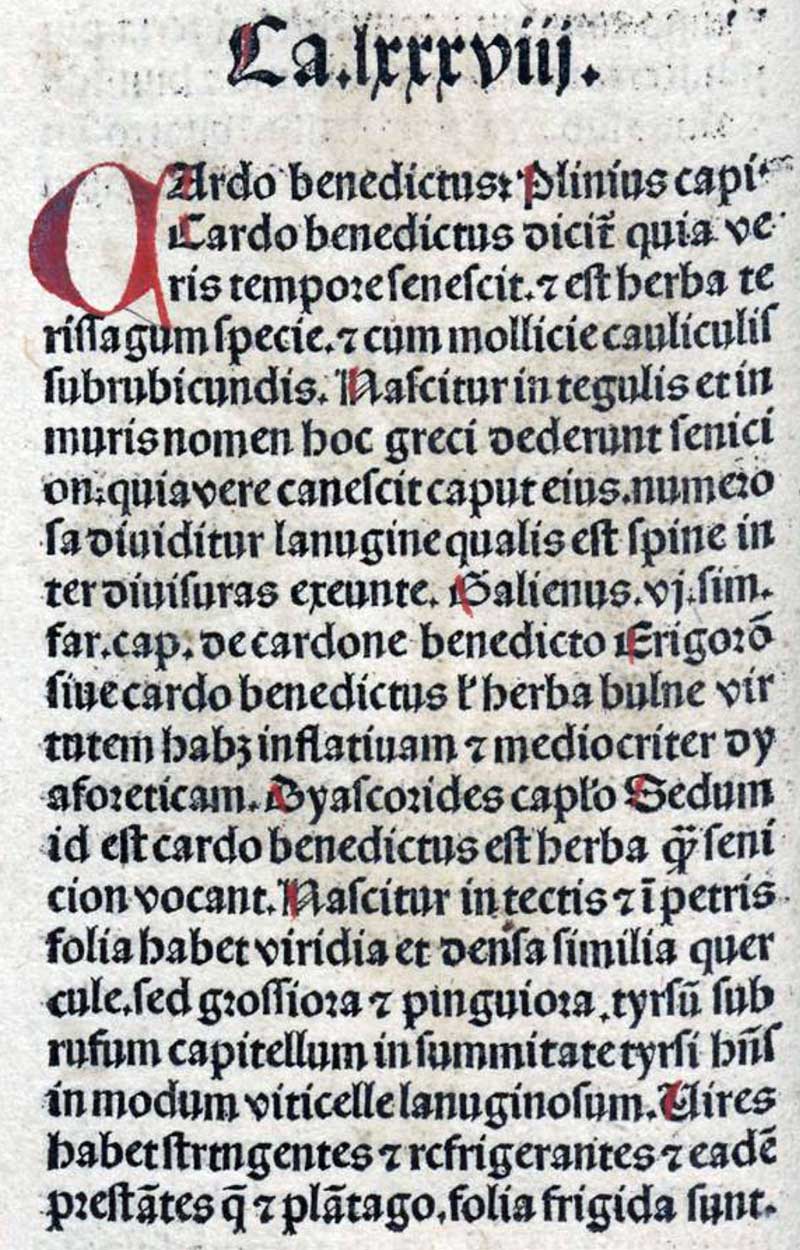Cynara, which is artichoke;
Original French: Cynara, c’eſt Artichault:
Modern French: Cynara, c’est Artichault:
Among plants named by metamorphosis of men or women.
Notes
Cardus
Cardus (text)
Cardo
Cardo (text)
Artischocke
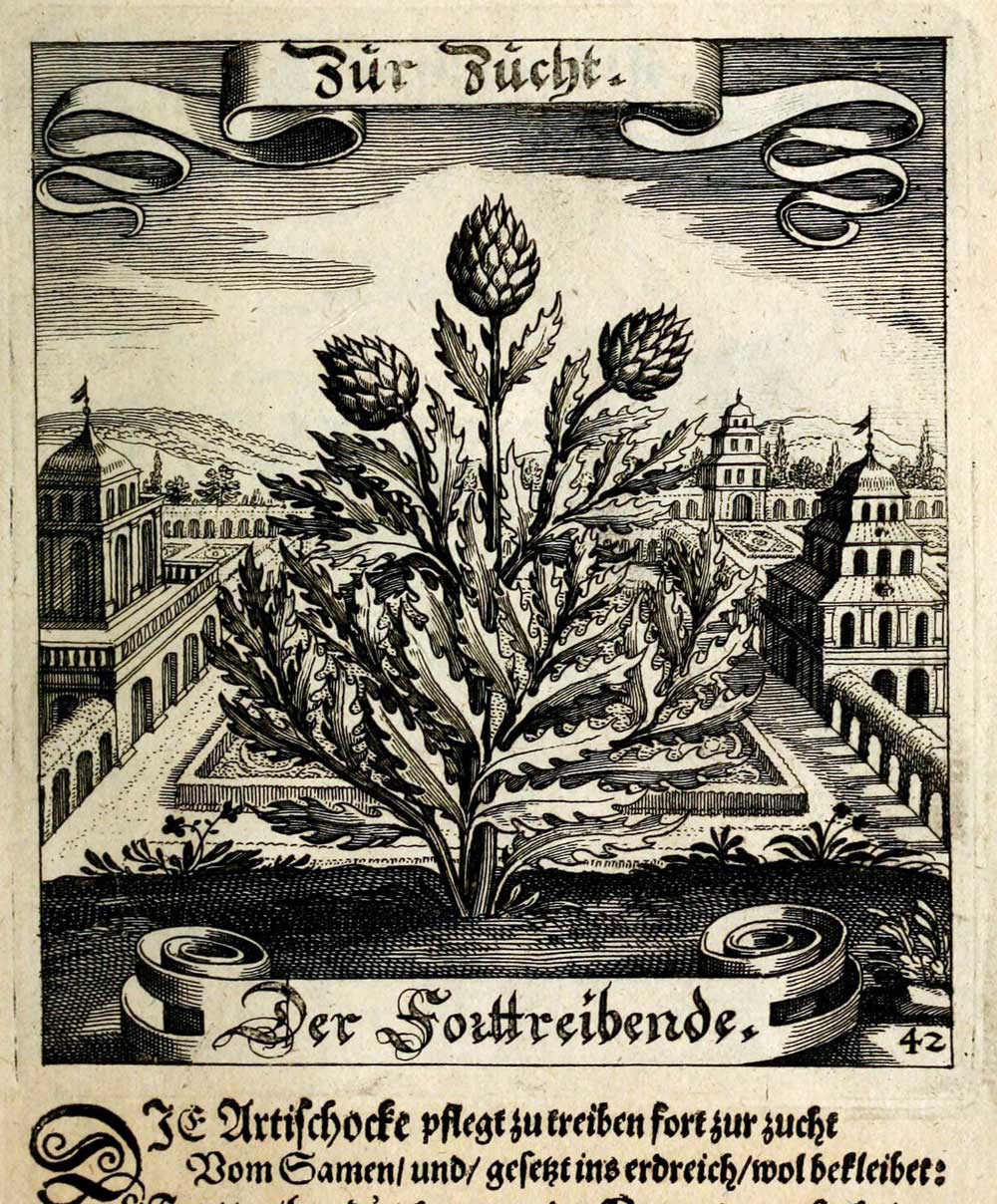
Cynara cardunculus L. [as Artischocke] [syn. Cynara communis Lam.]
Artichoke, cardoon, globe artichoke
cactus
Phaenias in Book V of On Plants (fr. 38 Wehrli) mentions a Sicilian cactus (kaktos), which is a spiny plant. Likewise Theophrastus in Book VI of On Plants (HP 6.4.10–11): The so-called kaktos is found only around Sicily, and not in Greece. It sends out stalks that spread out on the ground straight up from the root. It has a flat, spiny leaf; the term kaktos is properly applied to the stalks. They are edible when peeled, and are slightly bitter; and they preserve them in brine. Another type sends up an erect stalk, which they refer to as a pternix; this too is edible. After the downy parts have been removed, the flesh resembles palm heart. This too is edible, and their name for it is askalēron. Can anyone accept this evidence but lack the courage to say that this kaktos is what the Romans, who are not located far from Sicily, call kardos [Latin carduus/cardus (“thistle”), whence ultimately English “cardoon”] and what the Greeks patently refer to as kinara (“cardoon”)? Because if two letters were changed, kardos and kaktos would be the same word.
Cinarum
Cynara
According to Athenæus, the Egyptian king Ptolemy Energetes, of the second century before Christ, had found in Libya a great quantity of the wild kinara, by which his soldiers had profited. (Athenæus, Diepn., ii. 84)
Cynara, that is Artichokes
Athenaeus, 70 A-C. (Classical Museum cites Athen II. pp. 70, 71. Casaub.; Origin of Cultivated Plants
Cynara
Cynara, nom d’une fille qui fut, selon la fable rapportée dans le Banquet d’Athénée, métamorphosée en plante. On trouve dans Pline (VIII, 41) le mot Cinare. Mais les Kactos, Kinara et Scolimos des Grecs et le Carduus des Romains n’étaient que le Cardon, Cynara cardunculus, L. Les Anciens, selon Targioni, n’ont pas connu l’artichaut, Cynara scolymus, L., forme culturale probablement dérivée du précédent, qui fut apportée en 1466 de Naples à Florence, et importée en France au début du XVIe siecle. (Paul Delaunay)
cynare
Cf. De latinis nominibus, «Cinarum, artichault, a puella quae in eam plantam mutata est». [Artichoke, a plant from the girl who was changed into it.]
Cynara
Métamorphosée en cardon.
artichoke
artichoke. Forms: -chowe, artechock, -choke, archoke, artychough, harti-, artichock(e, chau(x, artichoake, -chou(x, -choach, hartichoak(e, -choke, hartechooke, artichoak, artichoke. [adaptation of north. Ital. articiocco, arciciocco, for arcicioffo (all in Florio), adaptation of or cognate with Old Spanish alcarchofa, adopted from Spanish Arabic al-kharshofa (P. de Alcala) = Arabic al-kharshu¯f. Like other words of foreign origin, much influenced in its forms by popular etymology. Association with native words, arci- arch-, chief, cioffo horse-collar, ciocco stump, must have caused the North Italian changes; in French the terminal –chau was variously assimilated to chou cabbage, chaud warm, hault, haut high, as artichau, -chou, -chaud, -chault, -chaut; the Italian and French forms were latinized in the 16th century as articoccus, -coctus, -cactus, all with plausible though delusory etymologies, cactus being actually the ancient Latin name of the Cardoon; in English, explanations of the name were found in its choking the garden or the heart (horti-, harty-chocks), or having a `chock’ or `choke’ in its heart. Hence also the change from -chock to -choak, -choke. As to alleged Arabic ardi-shauki¯, see Skeat.]
A composite plant (Cynara Scolymus), allied to the thistles, originally from Barbary and the south of Europe, widely cultivated in kitchen-gardens; its eatable parts are the fleshy bases of the involucral leaves or scales of the gigantic thistle-like flower, and its receptacle or `bottom,’ when freed from the bristles and seed-down or `choke.’ (According to De Candolle the Artichoke is only a cultivated variety of the Cardoon C. Cardunculus, and occurs nowhere truly wild. It was brought to Florence from Naples in 1466. For its introduction to England, see quot. 1599.)
1531 MS. Acc. Bk. in N. & Q. 2 Feb. (1884) 85/2 Bringing Archecokks to the Kings Grace.
1542 Boorde Dyetary xx. 280 There is nothing vsed to be eaten of Artochockes but the hed of them.
1548 William Turner The names of herbes in Greke, Latin, Englische, Duche, and Frenche Carduus should be wylde Archichoke, and Cinara shoulde be the gardin Archichoke.
1551 William Turner A new herball 87 Archy-chock.
1552 Richard Huloet Abcedarium Anglico Latinum, Thystle called archoke or cowe thistle, Scolymus.
1552 Huloet, Artochokes herbe, Cynara.
1555 W. Watreman Fardle of Facions i. iii. 37 Gardein Thistles (whiche we calle Hortichockes).
1563 Hyll Arte Garden. 101 The Artichocke groweth like in the heade unto the Pine apple.
1577 B. Googe Heresbach’s Husb. (1586) 63 a, The Hartichoch… is a kind of Thistell, by the diligence of the Gardner brought to be a good Garden hearbe.
1578 Henry Lyte, translator Dodoens’ Niewe herball or historie of plantes lxi. 522 Of Artechokes.
1589 Shuttlew. Stewards’ Acc. (1856) I. 53 A mayed wch broughte artychoughs, iiij d.
1598 Ben Jonson Every man in his humour iv. ii, Like a yong artichocke, that alwayes carries pepper and salt, in it selfe.
1599 Richard Hakluyt Diuers voyages touching the discouerie of America II. 165 In time of memory things haue bene brought in that were not here before, as… the Artichowe in time of Henry the eight.
1599 Mirr. Policie 71 [He] did not yet forget the niggardlinesse, but parted Lettice and Artichaux in two.
1601 Philemon Holland, translator Pliny’s History of the world, commonly called the Natural historie II. 78, I haue spoken somewhat of Thistles and Artichoux.
